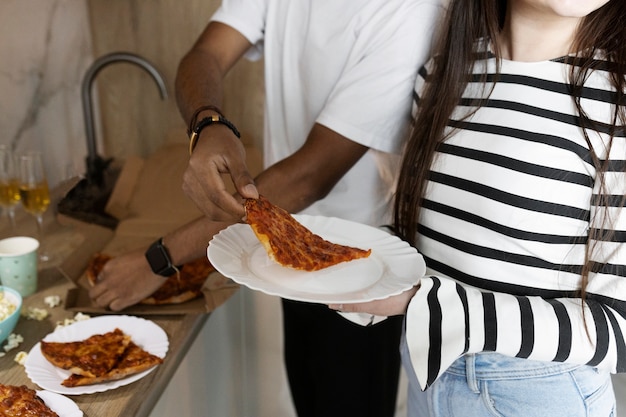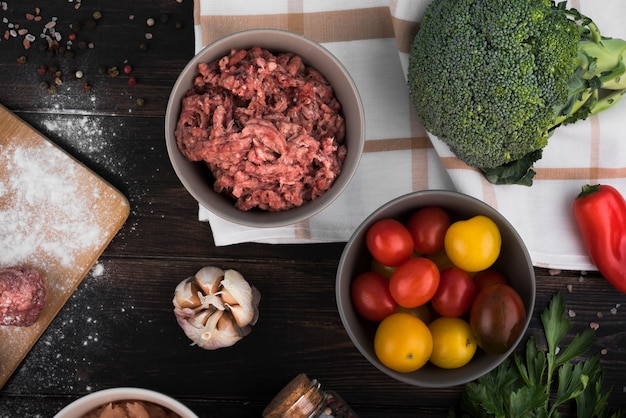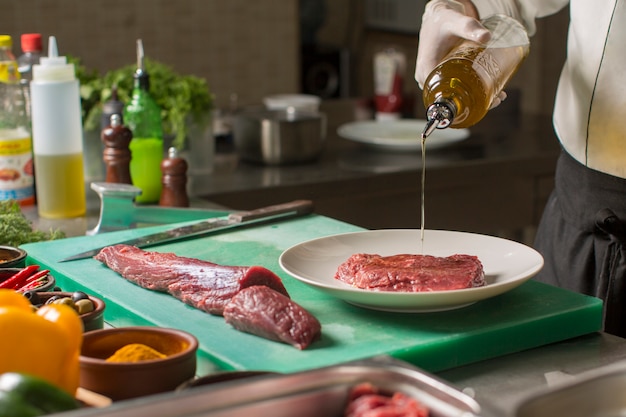Oh, corned beef. Just the thought of that salty, succulent, and undeniably comforting meat brings a warm glow to my heart. It's a dish that conjures up images of family gatherings, the aroma of hearty stews simmering on the stove, and the satisfying crunch of a good, old-fashioned reuben sandwich. But there's one question that often pops up when it comes to corned beef: how long do you actually cook it? That, my friends, is a question I'm here to answer. I've spent countless hours in the kitchen experimenting with various methods, and I've learned a thing or two about perfecting that corned beef.
(Part 1) The Ins and Outs of Corned Beef: A Journey Through History and Flavor

Before we dive headfirst into the world of cooking times, let's take a moment to appreciate corned beef itself. It's a fascinating piece of culinary history, and understanding its origins can help you appreciate the process of cooking it. Essentially, corned beef is a cut of beef, usually brisket, that's been cured in a brine containing salt, sugar, and various spices, most notably coriander and juniper berries. This curing process not only adds a wonderful depth of flavour but also helps preserve the meat. It's a technique that's been used for centuries, dating back to the days when refrigeration wasn't readily available.
The History of Corned Beef: From Salt to Savory
The term "corned" actually comes from the word "corn," which in the past referred to salt grains. So, corned beef literally means "beef preserved with salt grains." This technique was essential for preserving meat before refrigeration was commonplace. The salt draws out moisture from the meat, creating a salty, flavorful brine that acts as a natural preservative.
Why Brisket? The Perfect Cut for Braising
Now, you might be wondering, why brisket? Well, brisket is a tough cut of meat, and it needs long, slow cooking to break down those tough muscle fibers and become tender. That's where the magic of braising comes in. Corned beef, thanks to its curing process, is perfectly suited for braising. Think of it like this: the curing process gives the meat a head start on getting tender, and then braising brings it to the ultimate level of melt-in-your-mouth goodness. The long, slow cooking time allows the tough connective tissues to break down, resulting in a tender and flavorful brisket that practically falls apart at the touch of a fork.
(Part 2) The Art of Braising: Unlocking the Flavor Potential

Braising is the key to unlocking the full potential of corned beef. It's a cooking technique that involves a two-step process: searing the meat to create a flavorful crust, then simmering it in liquid for an extended period of time. That simmering step is where the real magic happens. The liquid, often a combination of broth, beer, or even just water, helps to keep the meat moist and tender, and the flavours from the spices and aromatics infuse the meat. It's a beautiful symphony of texture and flavour, resulting in a tender, juicy, and incredibly flavorful brisket.
Choosing Your Method: Stovetop, Oven, or slow cooker
You can braise corned beef on the stovetop, in the oven, or even in a slow cooker. Each method has its own pros and cons. Stovetop braising is the most traditional method and gives you the most control over the cooking process. You can easily adjust the heat and monitor the liquid levels to ensure your corned beef cooks evenly and doesn't dry out. Oven braising is a hands-off option, perfect for those busy days when you need to set it and forget it. The oven does the work for you, allowing you to focus on other tasks while the corned beef simmers to perfection. And slow cooking is a great option for achieving incredibly tender results. The slow, gentle heat of a slow cooker breaks down the toughest connective tissues, resulting in a brisket that practically melts in your mouth. The choice is yours, my friend!
Searing: A Crucial Step for Flavor and Texture
Searing the corned beef before braising is a step that's often overlooked but makes a huge difference in flavor and texture. Searing creates a beautiful, caramelized crust that adds an incredible depth of flavour to the meat. It's a simple step that transforms the corned beef from ordinary to extraordinary.
- For Stovetop Braising: Heat a large dutch oven over medium-high heat. Add a generous amount of oil and sear the corned beef on all sides until it's nicely browned. This step creates a flavorful crust and helps to lock in the juices, resulting in a more tender and flavorful brisket.
- For Oven Braising: Preheat your oven to 325°F (160°C). Heat a large Dutch oven or roasting pan over medium-high heat. Add a generous amount of oil and sear the corned beef on all sides until it's nicely browned. The searing process adds a wonderful depth of flavor, and the oven will do the rest, creating a tender and juicy brisket.
- For Slow Cooking: If you're using a slow cooker, you can skip the searing step. Just add the corned beef to the slow cooker and proceed with the braising instructions. The slow cooking process will naturally break down the tough connective tissues and create a tender and flavorful brisket.
(Part 3) The Big Question: How Long to Cook? Factors Influencing Your Timetable

Now, let's get to the heart of the matter: cooking time. This is where things get a little tricky because there's no one-size-fits-all answer. The cooking time will depend on a few factors:
Factors Affecting Cooking Time: The Recipe for Success
- Size of the brisket: A larger brisket will take longer to cook than a smaller one. Think of it like this: the larger the brisket, the more time it needs to reach that perfect level of tenderness.
- Thickness of the brisket: A thicker brisket will take longer to cook than a thinner one. The heat needs to penetrate the entire brisket, and a thicker cut naturally takes longer to cook through.
- Cooking method: Oven braising generally takes longer than stovetop braising. The oven provides a more consistent and even heat, which can result in a slightly longer cooking time. Slow cooking takes the longest but results in incredibly tender meat. The slow, gentle heat of a slow cooker allows the connective tissues to break down completely, resulting in a melt-in-your-mouth brisket.
- Desired level of tenderness: If you want your corned beef to be fall-apart tender, you'll need to cook it for longer. For a more substantial bite, you can cook it for a shorter amount of time.
As a general rule of thumb, you can expect to cook a 3-4 pound corned beef brisket for 3-4 hours on the stovetop, 4-5 hours in the oven, or 8-10 hours in a slow cooker. But remember, these are just estimates! The best way to determine doneness is to use the fork test, which we'll discuss in more detail in the next section.
(Part 4) The doneness test: How to Know When It's Ready
So, how do you know when your corned beef is cooked to perfection? It's not just about the time! You need to check for tenderness. Here's my tried-and-true method for testing doneness:
The Fork Test: A Simple Gauge of Tenderness
Use a fork to gently pierce the thickest part of the brisket. If the fork slides in easily and the meat pulls apart, it's done! If the fork meets resistance, the brisket needs more time. It's that simple!
(Part 5) What About the Liquid? A Symphony of Flavor
The liquid you braise your corned beef in is equally important. It plays a crucial role in keeping the meat moist and adding flavor. Here are a few ideas for braising liquids:
Braising Liquids: A Flavor Symphony
- beef broth: A classic choice that adds a rich, savory flavour. Beef broth provides a rich and flavorful base, enhancing the natural taste of the corned beef.
- Beer: Choose a beer that you enjoy drinking, as its flavor will infuse the meat. Beer adds a wonderful depth of flavor and creates a slightly caramelized aroma.
- Water: If you're keeping things simple, water works perfectly well. Water provides a neutral base, allowing the flavors of the spices and aromatics to shine through.
- Combination: Don't be afraid to get creative and combine different liquids for a unique flavour profile. For example, you could try a combination of beef broth and beer for a rich and complex flavor, or water and apple cider for a slightly sweet and savory flavor.
Don't forget the aromatics! Adding a few vegetables like carrots, onions, and celery to the braising liquid will enhance the flavour of the meat. These vegetables not only add flavor but also contribute to a beautiful broth that can be used for other dishes later on.
(Part 6) Cooking Times: A Quick Reference Guide
Here's a quick reference guide to help you get started with cooking your corned beef:
| Method | Cooking Time | Temperature |
|---|---|---|
| Stovetop | 3-4 hours | Simmer over low heat |
| Oven | 4-5 hours | 325°F (160°C) |
| Slow Cooker | 8-10 hours | Low setting |
Remember, these are just guidelines. Always check for doneness using the fork test. Adjust the cooking time based on the size and thickness of your brisket, and your desired level of tenderness.
(Part 7) The Art of Resting: Letting the Flavors Settle In
Once your corned beef is cooked, it's important to give it a good rest before slicing and serving. This allows the meat to reabsorb its juices and become even more tender. The resting process helps to ensure that the corned beef is evenly cooked and the juices are distributed throughout the meat, resulting in a more flavorful and tender final product. Let the brisket rest in the braising liquid for at least 30 minutes before slicing and serving.
(Part 8) Serving Up the Deliciousness: A Culinary Symphony of Flavors
And now, the moment you've been waiting for: serving time! There are endless possibilities when it comes to serving corned beef. Here are a few ideas to get you started:
Corned Beef Classics: A Trip Down Memory Lane
- Reuben Sandwich: A classic for a reason! Corned beef, sauerkraut, Swiss cheese, and Thousand Island dressing on rye bread. This iconic sandwich is a true testament to the deliciousness of corned beef.
- Corned Beef Hash: A hearty and satisfying breakfast dish. Fry diced potatoes and onions, add shredded corned beef, and top with a fried egg. A perfect way to start your day, this dish combines the savory flavors of corned beef with the comforting textures of potatoes and onions.
- Corned Beef and Cabbage: A traditional Irish dish. Serve the corned beef with boiled cabbage and boiled potatoes. This classic dish is a staple of Irish cuisine, showcasing the versatility of corned beef and its ability to complement other flavors.
Getting Creative with Corned Beef: Beyond the Classics
But don't be afraid to get creative! Corned beef is a versatile ingredient that can be used in a wide range of dishes. Try it in tacos, salads, or even pizza. The salty and savory flavors of corned beef can add a unique twist to your favorite recipes.
(Part 9) FAQs: Your Corned Beef Queries Answered
Now, you've got the basics down, but you might still have a few questions. Let's tackle some of the most common ones:
1. Can I cook corned beef in a pressure cooker?
Yes, you can! A pressure cooker will significantly reduce the cooking time. However, it's important to note that pressure cooking can result in a less tender brisket. The intense heat and pressure of a pressure cooker can make the meat tough if you're not careful. Use caution when pressure cooking corned beef, as it can easily become overcooked. If you do choose to use a pressure cooker, be sure to adjust the cooking time accordingly and check for doneness using the fork test.
2. Can I freeze leftover corned beef?
Absolutely! Freeze the leftover corned beef in an airtight container for up to 3 months. Thaw the corned beef in the refrigerator overnight before reheating. Freezing leftover corned beef is a great way to save time and prevent waste. Just be sure to thaw it properly in the refrigerator to ensure that it's safe to eat.
3. What can I do with the leftover braising liquid?
Don't throw it away! The braising liquid is packed with flavor. You can use it to make a delicious soup, gravy, or even as a base for a risotto. The braising liquid is a flavorful treasure trove that can be used to create a variety of delicious dishes.
4. What are the best sides to serve with corned beef?
Classic sides for corned beef include boiled cabbage, boiled potatoes, mashed potatoes, and rye bread. You can also get creative with other sides like roasted vegetables, green beans, or a simple salad. The choice of sides is really up to you and your preferences.
5. How do I make the perfect Reuben sandwich?
The key to a perfect Reuben sandwich is to use thinly sliced corned beef, good quality sauerkraut, Swiss cheese, and a creamy Thousand Island dressing. Use rye bread that's been toasted for a crispy texture. The combination of flavors and textures is what makes the Reuben sandwich such a classic.
There you have it! Now you're armed with all the knowledge you need to confidently cook a delicious corned beef. Remember, the key is to embrace the process and enjoy the journey. And most importantly, have fun with it!
Everyone is watching

How to Cook Frozen Lobster Tails Perfectly: A Step-by-Step Guide
RecipesLobster. Just the word conjures up images of lavish meals, special occasions, and a taste of luxury. But let's...

Pigs in a Blanket Cooking Time: How Long to Bake for Perfect Results
RecipesAh, pigs in a blanket. Just the name conjures up images of those delightful little parcels of crispy pastry en...

Pork Fillet Cooking Time: How Long to Cook It Perfectly
RecipesPork fillet, or tenderloin as it's sometimes called, is a real favourite in our house. It's so versatile, and...

The Ultimate Guide to Cooking Delicious Frankfurters
RecipesLet's face it, we all love a good frankfurter. It's a classic, simple, and always satisfying. But let's be rea...

Wolf Meat Recipes: A Guide to Cooking Wild Game
RecipesLet's be honest, you don't see wolf meat at your local butcher shop every day. It's a bit of a wild card, but ...
